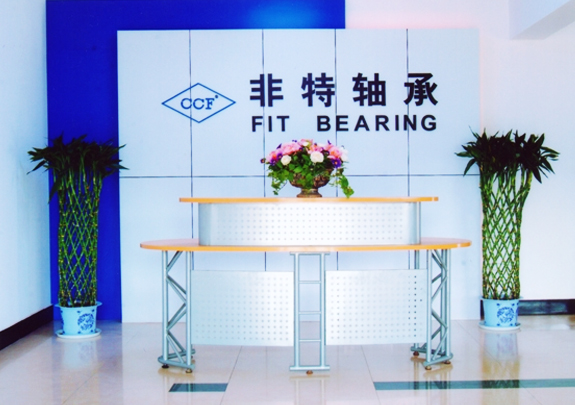| Bearing No. | Main Dimensions | Basic rating Dynamic load Cr(KN) | Basic rating Static load Cor(KN) | Limiting Speed (r/min) | Weight(kg) | |
| dxDxB (mm) | Grease lubrication | Oil lubrication | ||||
| 6007 2RS | 35×62×14 | 12.47 | 8.66 | 12000 | 14000 | 0.155 |
| 6204 RS C3 | 20×47×14 | 12.79 | 6.58 | 15000 | 18000 | 0.104 |
| 6204 2RS | 20×47×14 | 12.79 | 6.58 | 15000 | 18000 | 0.104 |
| 6205 2RS | 25×52×15 | 14.02 | 7.88 | 13000 | 15000 | 0.129 |
| 6206 2RS | 30×62×16 | 19.5 | 11.2 | 11000 | 13000 | 0.199 |
| 6207 2RS/ZZ | 35×72×17 | 25.67 | 15.3 | 9500 | 11000 | 0.288 |
| 6304 2RS | 20×52×15 | 15.9 | 7.8 | 14000 | 17000 | 0.144 |
| 6305 2RS | 25×62×17 | 20.6 | 11.2 | 11000 | 13000 | 0.235 |

Zhejiang Fit Bearing Co., Ltd. was established in November 2003 with a registered capital of USD 2 million. The plant covers an area of 35,000 square meters and 20,000 square meters, with more than 120 workers and more than 20 technical management personnel.
At the beginning of its establishment, the company specialized in producing all kinds of low-noise long-life ball bearings. As a professional Wholesale Cotton Picker Bearings Manufacturers and Cotton Picker Bearings Factory, After years of development in the bearing industry, we have accumulated rich experience in production and management. In 2013, we began to vigorously develop agricultural machinery parts and construction machinery parts. At present, we have formed a team with exquisite technology and excellent management, capable of R&D, manufacturing, sales and service in the bearing industry and agricultural machinery parts. After years of hard work and development, we have formed a capable R&D and manufacturing team. They have rich knowledge and experience in materials, heat treatment, machining and grinding. There are currently 9 professional R&D engineers responsible for the development of new products.
The main shaft bearing is the most important component in the engine. If the main shaft bearing fails, it will directly cause the engine to stop running. In ord...
Read MoreBearing failure is a common problem during the operation of bearings, and the form of wear is a type of bearing failure. Wear can also cause significant damage ...
Read MoreThe working temperature of cylindrical roller bearings depends on various factors, including the heat output of all relevant heat sources, the heat flow rate be...
Read MoreOn December 9-12, 2020, the 17th "2020 China International Bearing and Special Equipment Exhibition" was grandly held at the National Convention and Exhibition ...
Read MoreRolling bearings are widely used as important mechanical basic components in various fields of the national economy and national defense. The machinery and work...
Read MoreHow do you determine the load capacity of cotton picker bearings?
To determine the load capacity of cotton picker bearings, you can follow these steps:
1. Identify the specific type and model of the cotton picker bearings you are using. This information can typically be found in the bearing specifications or technical documentation provided by the manufacturer.
2. Look for the load ratings provided by the manufacturer for the particular bearing model. These load ratings are usually given as dynamic load rating (C) and static load rating (Co).
3. The dynamic load rating (C) indicates the load that a bearing can withstand for a million revolutions without experiencing excessive wear or fatigue. It is typically expressed in Newtons (N) or kiloNewtons (kN). This value can be used as a reference to determine the load capacity.
4. The static load rating (Co) indicates the maximum load that a bearing can handle without permanent deformation. It is also expressed in Newtons (N) or kiloNewtons (kN). This value provides information about the maximum static load capacity of the bearing.
5. Compare the load requirements of your cotton picker application with the load ratings provided by the manufacturer. Ensure that the calculated loads (taking into account both radial and axial loads) are within the specified load capacity of the bearings.
How can bearing performance be optimized for maximum productivity in cotton pickers?
To optimize bearing performance for maximum productivity in cotton pickers, you can consider the following tips:
1. Proper lubrication: Ensure that the bearings are adequately lubricated with the recommended grease or oil. Regularly inspect and replenish lubrication as needed to prevent excessive wear and friction.
2. Prevent contamination: Keep the bearing housing clean and free from dirt, debris, and other contaminants that can compromise the performance and longevity of the bearings. Use protective seals and covers when necessary.
3. Regular maintenance: Schedule and perform regular maintenance checks to identify any signs of wear, damage, or misalignment. Replace worn or damaged bearings promptly to avoid costly downtime and reduced productivity.
4. Correct alignment: Verify that the bearings are aligned correctly and properly installed. Misalignment can lead to increased stress and premature failure of the bearings. Adjust and align as needed to ensure smooth operation.
5. Temperature control: Monitor and control the operating temperature within the recommended range. Extreme heat or cold can impact bearing performance and reduce productivity. Consider using temperature monitoring systems or cooling mechanisms if necessary.
6. Load distribution: Distribute the load evenly across the bearings to prevent excessive stress on individual bearings. Consider adjusting the placement of belts, pulleys, or other load-bearing components to achieve a balanced load distribution.